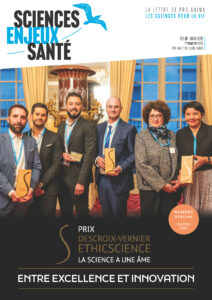
Brazilian Chemical Management Bill, Call for US Central NAMs Data Hub, Survey on Reviewer Requests for Animal Experiments in India, and more
News on non-animal methods
NOV. 04 - 08, 2024NEWS, REPORTS & POSITION STATEMENTS
1. Brazilian Senate : A chemicals management bill to limit animal testing to a “last resort”
Brazil’s Senate has approved a new chemical management bill that restricts animal testing to a “last resort” and requires development of a strategic plan to fully transition away from animal use. These measures, if endorsed by Brazil’s president, will compel the adoption of modern, human-relevant science, benefiting citizens, the environment, and animals alike.
“We commend the Government and Congress for their leadership in protecting animals used in chemical safety testing. By prioritizing animal-free methods, Brazil is positioning itself as a leader in ethical science and setting an example for other countries to follow” said Antoniana Ottoni, senior federal affairs specialist for Humane Society International in Brazil.
2. NICEATM : Defined approaches to identify potential skin sensitizers
Skin sensitizers are substances with the potential to cause allergic contact dermatitis, an allergic reaction that is often initiated through covalent binding of substances to skin proteins. Potential skin sensitizers can be identified without animal testing using defined approaches to testing and assessment. NICEATM has been working with National Toxicology Program (NTP), ICCVAM, and industry scientists, on evaluated defined approaches to identify potential skin sensitizers based on this adverse outcome pathway.
NICEATM recently developed the DASS App, a user-friendly web app that uses the defined approaches from OECD Guideline 497 to predict skin sensitization hazard and potency. The most recent updates to the DASS App were presented in a poster (To et al.) at the 12th Annual Meeting of the American Society for Cellular and Computational Toxicology.
3. The Dutch Centre for Animal-Free Biomedical Translation : Website launched !
The Centre for Animal-Free Biomedical Translation (CPBT, in Dutch : Centrum voor Proefdiervrije Biomedische Translatie) is a national center for valorizing and disseminating animal-free innovations and expertise. It aims to improve and accelerate the translation of new biomedical innovations to patients and users, with lower costs and without the use of animals. This will lead to safer, more effective, and better medicines while reducing animal testing.
The CPBT received a positive funding recommendation from the Nationaal Groeifonds (NGF) earlier this year. The total budget available to the CPBT in the period from 2025 to 2034 is 245 million euros. 124.5 million of this budget is an investment from the NGF, the other funds are being contributed by public and private CPBT partners. CPBT operations are starting up, the center is expected to become fully operational soon. You can join the mailing list to stay up to date about the latest CPBT news and developments.
TOOLS, PLATFORMS, CALLS
4. NIH : Funding call for a central NAMs data hub
The overarching goal of the US Complement-ARIE program is to catalyze the development, standardization, validation, and use of human-based NAMs that will transform the way we do basic, translational, and clinical sciences. The NIH Common Fund’s Complement-ARIE program will be releasing a funding call for applications to help create a central NAMs data hub that is searchable, adheres to standards & FAIR principles (Findable, Accessible, Interoperable, Reusable), and includes dissemination & outreach tools.
Estimated Publication Date of Notice of Funding Opportunity : November 29, 2024
First Estimated Application Due Date : March 10, 2025
5. Experiences with reviewer requests for animal experiments in India
Have reviewers of manuscripts or grants asked you for animal data even when it wasn’t scientifically justified ? Humane Society International India, in collaboration with IndiaBioscience and Centre for Predictive Human Model Systems is conducting a survey to understand peer reviewer expectations and requests for animal-based research methods and authors’ perceptions of these requests.
If you agree to take part in this survey, you will be asked to answer a few demographic questions about yourself, questions about your use of research animals and other methods, as well as questions about your experiences and perceptions during manuscript submission when peer reviewers request animal-based experiments to be added to studies performed without the use of animals. Responses to all questions are required, except open-ended questions. The survey is estimated to take about 5 minutes total.
6. Call for papers : Hepatotoxicity mechanisms and animal-free prediction models
Because of ethical and scientific reasons, there is a clear tendency to step away from animal testing for assessing and studying the hepatotoxic potential of xenobiotics by relying on technologies, such as cell culture techniques and computational approaches. Research regarding the development and, in particular, the application of these in vitro and in silico methods for hepatotoxicity testing purposes is gaining momentum, yet deals with a number of challenges, such as those related to modelling idiosyncrasy and mixture effects.
The journal Toxicology just launched a special issue that welcomes original research papers and review papers addressing hepatotoxicity with a focus on underlying mechanisms and prediction models devoid of animal experimentation. Manuscripts can be submitted by researchers from various sectors, including, but not limited to, academia, industry, and regulatory/governmental agencies, and preferably, yet not necessarily, have an interdisciplinary dimension.
Submission deadline : March 31st 2025
7. FC3R Short Notes platform is evolving
The French 3R Center Short Notes platform is evolving to better align with international standards and enhanced transparency. The scientific interest or novelty still remains the domain of traditional Scientific Journals because the purpose of Short Notes is different. A Short Note sits between a preprint and a paper. It is about broadening the field and scope of known results, combating the reproducibility crisis by sharing all those experiments never published.
Any results could change the game : identify publications with reproducible results, share experimental conditions that did or did not work, prevent others from repeating experiments under the same conditions, avoid unnecessarily animal uses in experimental conditions that do not work, save on resources by publishing tests on antibodies, extracellular matrices, or other substitutes, both within your team or lab and with other scientists across the globe.
Read more and commit to this Open Science
SCIENTIFIC DISCOVERIES & PROTOCOLS
8. In vitro pharmacological profiling aids systemic toxicity assessment of chemicals
An adapted in vitro pharmacology profiling panel (APPP) was developed that included targets used in the pharmaceutical industry alongside additional targets whose cellular functions have been linked to systemic toxicities. This panel of 83 target assays was used to profile the activities of 129 cosmetic relevant chemicals with diverse chemical structures, physiochemical properties and cosmetic use types.
In this new study, internal data consistency was proved robust, as evidenced by the good reproducibility between single concentration and concentration-response data and showed good concordance with data reported in the ToxCast and drug excipient datasets. The authors discussed how the data can be analyzed and multiple potential contexts of use illustrated by case studies, alongside other new approach methodologies, to support cosmetic chemical risk assessments that do not require data from new animal studies.
9. A comprehensive transcriptome characterization of individual nuclear receptor pathways in the human small intestine
Nuclear receptors (NRs) are widely expressed transcription factors that bind small, lipophilic compounds and regulate diverse biological processes. In the small intestine, NRs are known to act as sensors that control transcriptional responses to endogenous and exogenous signals, yet their downstream effects have not been characterized extensively.
Recent work from Prof Hans Clevers’s lab investigates the activation of six different NRs individually in the human small intestine, using intestinal organoids and small molecules agonists. They could observe changes in key enterocyte functions such as lipid, glucose, and amino acid absorption, the regulation of electrolyte balance, and drug metabolism.explored the role of multiple nuclear receptors.This study provides an unbiased and comprehensive transcriptomic description of individual NR pathways in the human small intestine, contributing to the understanding of NR in intestinal homeostasis in humans.


